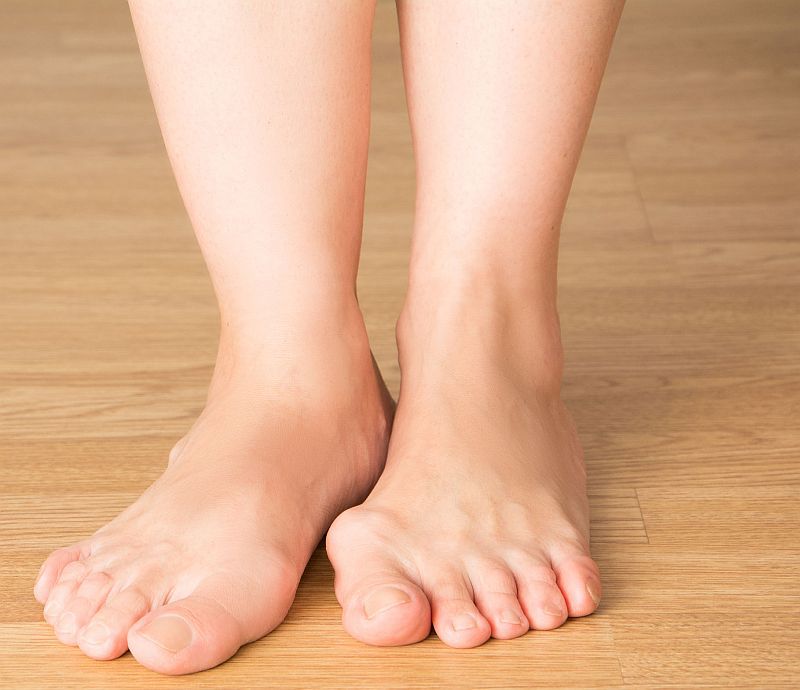How to form and how to prevent them!

Halves or Hallux Valgus represent a deformity of the big toe of the foot called haluce that occurs by deviating the tip of the halus to the other fingers accompanied by the medial deflection of the metatarsus towards the inside of the leg forming a painful and unsightly prominence. This deformity worsens over time, the metatarso-phalangian angle and intermetatarisan becomes bigger and the foot deforms. A normal metatarsal angle is less than 9 degrees and metatarso-phalangian less than 15 degrees. It occurs more frequently in women than in men, especially in stylish women who wear heels and narrow shoes. The exact cause of the mounts is unknown, but there are several associated risk factors where studies have shown that people with family history are more likely to Evolution may be a rapid or slow one, this protuberance of the head of the metatars, causing the patient a particular discomfort when wearing narrow shoes, because of shoe skin rubbing a painful erythema area sometimes accompanied by bursitis. By deviating the metatarsus outwards and by the fact that the sesamiode bones remain in place, the support zones of the foot change, and the tip of the hump pushes the second finger, deforming it, and joins the legs on the plantar side of the foot.
Symptoms are manifested by the difficulty of wearing footwear, especially the narrow ones, pain in the metatarso-phalangiene joint at rest and exertion, inflammation of the skin and the appearance of finger deformities one and two. Diagnosis is based on a clinical examination of the leg in a clinostatism and orthostatism to assess the effect of the supporting forces in the metatarsal deflection, accompanied by a radiograph of the leg in the orthostatism to correctly calculate the intermetalarsian and metatarso-phalangitic angles and also to check the position of the bone . Incipient treatment can be an orthopedic one by reducing stress on the toothbrush by changing the narrow shoe with a wide and comfortable one, wearing ortheses at night and removing fingers supported by local and oral anti-inflammatory treatments to help reduce pain and local inflammation. All of these methods may be delayed but can not stop the evolution of the mounts. Surgical treatment is currently represented by more than 10 different techniques for treating the mounts by reassuring the bone or by strengthening the musculoskeletal system of the hallucid.
The most commonly used osteotomy is chevron, scarf and akin osteotomy, where the bone is cut, repositioned at the correct anatomical angle and secured with special screws, which allow for the correction of the leg support zones and the disappearance of the painful protrusion of the metatarsus. Recovery is a fast, painless, with good results if new methods and new treatment principles are used, the patient goes without the need for carriages, but with just one orthopedics from the first postoperative day. Do not avoid surgical treatment, have a better result at the incipient stages when it comes to advanced pain with high fingers, and always call a physician experienced and familiar with all new treatment methods of the mounts. Author: Doctor ortoped Tarek Nazer, orthopedic surgeon and traumatology specialist, specialist in arthroscopic surgery, sports injuries and personalized prostheses.
.
Source : csid.ro
Views : 3473
Popular Article
- (photo) Nude becomes art.
Posted: 2018-03-17, 9759 views.
- The harmful effects of air conditioning on the skin
Posted: 2017-06-08, 8469 views.
- 3 causes of dyed hair discoloration
Posted: 2017-06-15, 8350 views.
- Why early puberty occurs in girls: symptoms, favors, diagnosis and treatment
Posted: 2017-10-24, 8191 views.
- Good or bad skin treatments in the hot season
Posted: 2017-06-07, 7921 views.
Recommendations
- (photo) Nude becomes art.
Posted: 2018-03-17, 9759 views.
- The harmful effects of air conditioning on the skin
Posted: 2017-06-08, 8469 views.
- 3 causes of dyed hair discoloration
Posted: 2017-06-15, 8350 views.
- Good or bad skin treatments in the hot season
Posted: 2017-06-07, 7921 views.
- Risks of practicing sports on hot days
Posted: 2017-06-12, 7502 views.
 4 effective ingredients in the fight against acne.
4 effective ingredients in the fight against acne. How to get rid of hiccups fast
How to get rid of hiccups fast The wheat bran diet: the secret of lost pounds as if by magic
The wheat bran diet: the secret of lost pounds as if by magic The recipe that will sweeten your soul this weekend!
The recipe that will sweeten your soul this weekend!  Is it dangerous or not to refreeze meat after thawing it?
Is it dangerous or not to refreeze meat after thawing it?  The unusual sign of diabetes indicated by saliva.
The unusual sign of diabetes indicated by saliva. What to drink to boost your immune system.
What to drink to boost your immune system. 10 foods that help you never age.
10 foods that help you never age. What actually happens in your body if you drink a cup of coffee for breakfast
What actually happens in your body if you drink a cup of coffee for breakfast 5 surprising benefits of chia seeds
5 surprising benefits of chia seeds